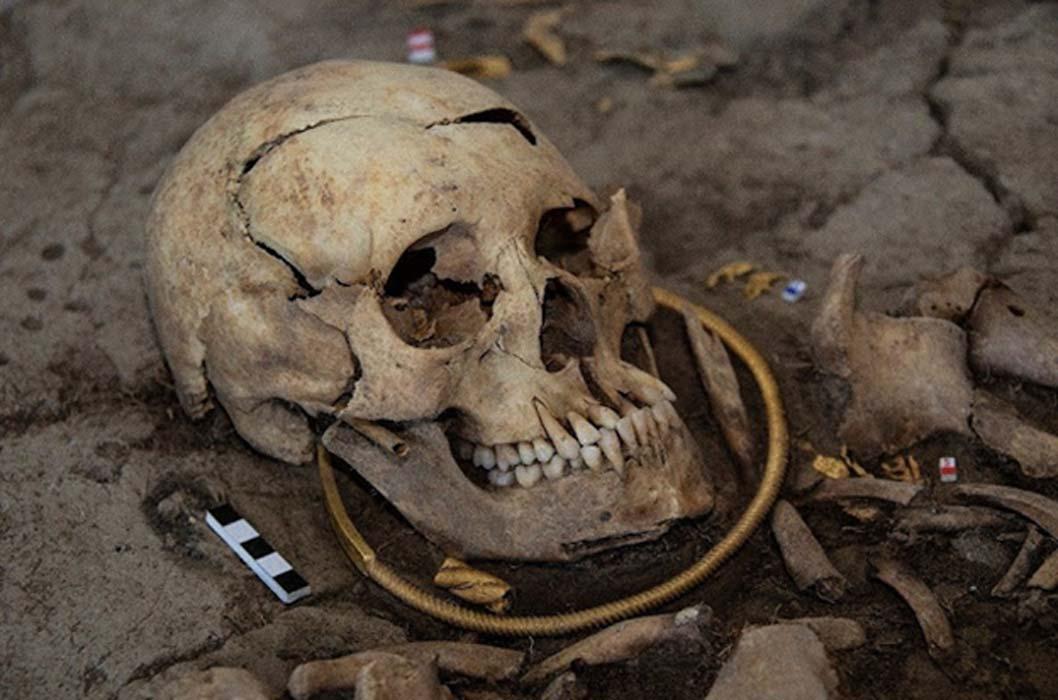Unraveling Iron Age Saka Culture through Ancient DNA Analysis in Kyrgyzstan





The Genetic Tapestry of Iron Age Saka Culture
The mighty Saka, a remarkable nomadic civilization of the Iron Age, left their indelible mark on the vast Eurasian Steppe. Recent archaeological and genetic studies have revealed extensive insights from the Boz-Barmak burial ground in Kyrgyzstan, where the remains of twelve individuals, encased in timber and encircled in stone, whisper tales from the 4th-2nd centuries BCE. These findings offer an enthralling glimpse into the genetic mosaic, social structure, and cultural complexity of this ancient society that flourished in the heart of Central Eurasia.
Hidden within the embrace of the Boz-Barmak mountains, the archaeological site sits southeast of Balykchi town in Kyrgyzstan, near the southwestern shores of the mystical Issyk-Kul Lake. Discovered during rescue excavations in 2022 due to railway construction, this burial site comprises fourteen singular resting places aligned in a dramatic north-south chain, showcasing the architectural prowess and ritualistic practices of the ancient Saka elite. The burial structures, with their wooden frames and clay-bound mounds stabilized by stone rings, reflect a society steeped in sophisticated craftsmanship and communal labor organization.
The burial sites, known as kurgans, varied significantly in their grandeur, with diameters ranging from seven to fourteen meters and heights reaching approximately one meter. This variation hints at a nuanced social hierarchy within Saka society. These kurgans were meticulously constructed with layers of timber, shrubs, and clay blocks, demonstrating the care taken to honor the deceased and preserve their remains for eternity. The larger structures, including Kurgans 5, 8, 10, 11, and 13, flaunt their impressive size as testament to the individuals' esteemed status, possibly military leaders, community stalwarts, or influential figures who commanded respect in life.
Our fascination with the past often begins in books and museums - but some of the most revealing clues lie within our own DNA. You can explore these genetic echoes of history at www.mytrueancestry.com.
The archaeological treasures discovered within these burial mounds paint a vivid picture of Saka material culture and artistic sophistication. Kurgan 10 emerges as possibly the oldest among the sequence, containing remarkable artifacts such as a golden rhombus-shaped plate and ceremonial jars with trefoil motifs, hinting at pre-Hellenistic cultural influences. These exquisite items, along with delicate golden earrings, elaborately crafted bone buckles adorned with vegetal motifs, bronze folding mirrors, and intricate braided headdresses, highlight the aesthetic refinement and cultural wealth of the Saka people.
Perhaps most significantly, the grave goods reveal fascinating insights into gender dynamics within Saka society. The women buried at Boz-Barmak, their graves adorned with jewelry and artifacts indicative of high status, appear to have participated actively in the martial and political arenas of their day. Kurgan 13, for instance, contained the remains of a female figure accompanied by a gold ring earring and other prestigious items, suggesting a society where female authority had space to flourish alongside, and sometimes despite, patriarchal traditions. This evidence challenges conventional assumptions about gender roles in ancient nomadic societies and suggests a more complex social structure than previously understood.
Cutting-edge DNA analysis of these ancient individuals paints a vivid tapestry of their genetic origins, linking them to diverse ancestral groups across ancient Central Eurasia and Siberia. Through meticulous ancient DNA extraction and analysis of nine individuals, researchers uncovered a fascinating genetic landscape that reveals both continuity and diversity within the Saka community. Particularly striking is the discovery that male lineages exhibit remarkable continuity with present-day Kyrgyz and Tajik populations, tracing a genetic signature that has persisted across millennia despite numerous historical upheavals and population movements.
The genetic modeling reveals a cosmopolitan identity, with Saka individuals embodying an extraordinary amalgamation of ancestries. Their genetic makeup includes contributions from Scythian-related groups, such as the Sargat people of Siberia, and traces of Cimmerian ancestry from the Pontic-Caspian Steppe. This rich interplay of eastern and western Eurasian ancestries hints at complex historical migrations, cultural exchanges, and intermarriage patterns that shaped the genetic landscape of the ancient steppe peoples. The diversity observed in their DNA reflects the dynamic nature of nomadic societies and their extensive networks of interaction across vast geographical distances.
The genetic evidence reveals intricate kinship patterns that transcend simple grave markers and burial arrangements. Analysis shows a complex network of second- and third-degree relationships among the buried individuals, suggesting sophisticated social ties that bound the Saka community together. Remarkably, while no first-degree relatives were found buried together at the site, the presence of more distant genetic relationships indicates a carefully organized social structure that may have deliberately separated immediate family members in death while maintaining broader kinship connections.
The homogeneity observed in male Y-chromosome lineages, with all analyzed males sharing the same haplogroup, contrasts sharply with the notable diversity found in female mitochondrial DNA. This pattern aligns perfectly with cultural practices of patrilocality, where men remained close to their ancestral homes while women moved between communities through marriage and other social arrangements. This mobility of women served to knit together a wider genetic and social fabric, introducing new genetic lineages and cultural practices while maintaining the patrilineal core of Saka society.
The evidence suggests a system that might be termed "meritocratic patrilineal succession," where leadership and authority could flow through extended family networks rather than strict father-to-son inheritance. This flexible approach to power transmission appears to have allowed for the recognition of exceptional individuals regardless of gender, providing pathways for capable women to assume positions of authority and influence within their communities.
The Boz-Barmak burial ground stands as more than merely a resting place for ancient elites; it serves as a remarkable window into a sophisticated nomadic civilization that successfully balanced tradition with adaptation. The site reveals a society characterized by complex social hierarchies, extensive trade networks, artistic achievement, and flexible approaches to leadership and gender roles. The careful arrangement of the kurgans, the wealth of grave goods, and the genetic diversity of the buried individuals all point to a culture that was both deeply rooted in steppe traditions and remarkably open to external influences and innovations.
The Saka culture, as revealed through the Boz-Barmak discoveries, represents a pivotal chapter in the historical geography of Central Eurasia. Their story illustrates the dynamic interplay of migration, cultural exchange, and social adaptation that characterized the ancient world. Through the integration of archaeological evidence and genetic analysis, we gain unprecedented insights into how these nomadic peoples navigated the challenges of their environment while maintaining complex social structures and extensive networks of interaction across the Eurasian continent.
https://www.biorxiv.org/content/10.1101/2025.11.03.686206v1
Discover how your DNA connects to ancient civilizations at www.mytrueancestry.com.
Comments